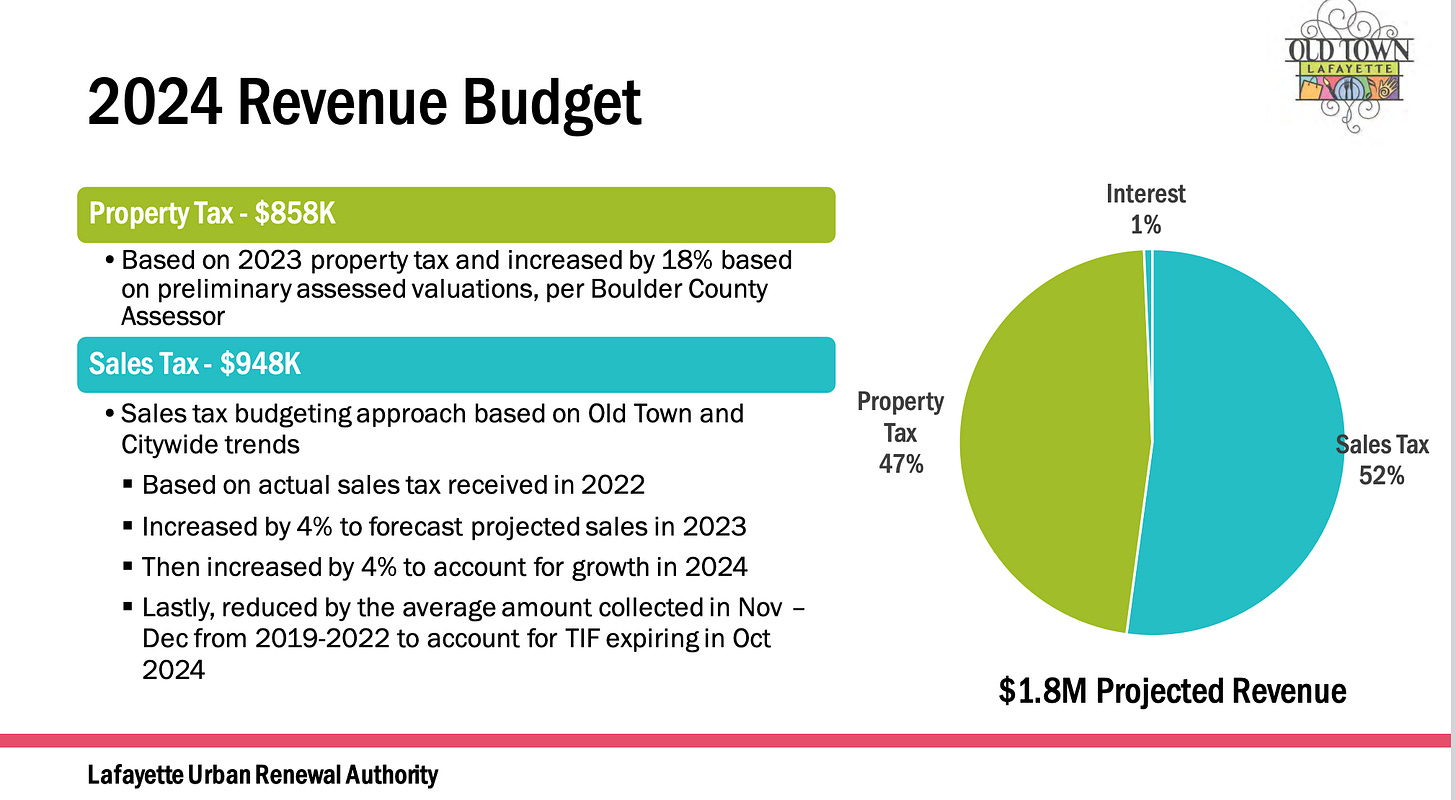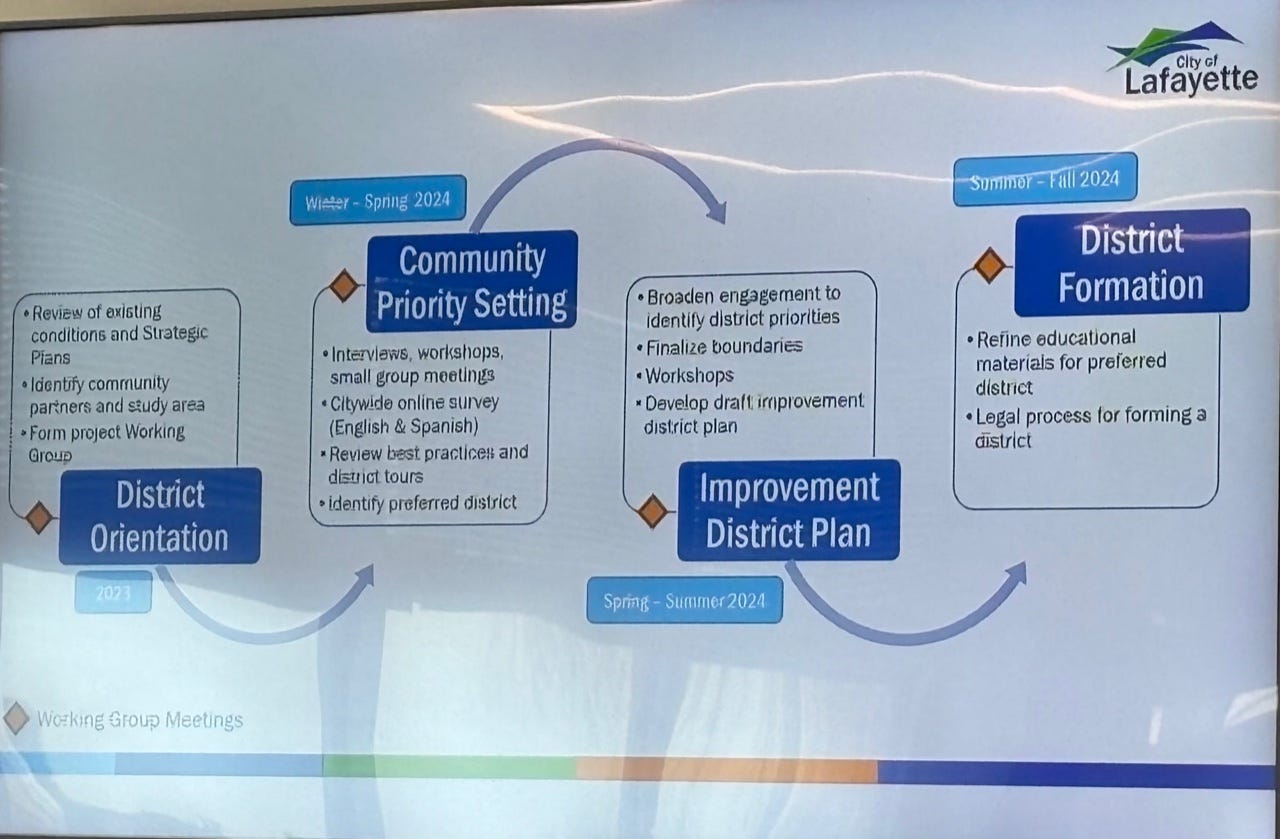Time for another report from Vicky Uhland!
What do you want to see happen in downtown Lafayette in the future? And do you think your tax dollars should be spent on that vision?
These questions are particularly relevant this year. As Karen Norback wrote in her excellent piece Following The Money - Part Three: Downtown, for almost 25 years, much of Lafayette’s downtown has been part of the Lafayette Urban Renewal Authority, or LURA. During this time, LURA has collected tens of millions of dollars in sales and property taxes that are specifically earmarked for removing blight inside the district.
That’s set to end soon. Under the terms of Lafayette’s urban renewal plan, LURA’s tax increment financing, or TIF, will expire in October. (Karen explains how the TIF works here.) But, to paraphrase the great poet Dylan Thomas, this doesn’t mean LURA will go gently into that good night this fall.
Instead, Executive Director Brigid Keating says LURA will exist until it spends the remaining money in its budget—which is projected to be about $1.8 million in 2024.
There’s no deadline for spending this money, meaning that LURA could potentially continue for months or even years after October—it just won’t receive any new funding during that time.
THE LURA TRANSITION PROJECT
In keeping with the Dylan Thomas theme, LURA is also raging against the dying of the light in another way.
Last year, LURA and the city of Lafayette launched Old Town Tomorrow: The LURA Transition Project. This included hiring a consultant to look into what could potentially replace LURA, and also appointing the Old Town Working Group.
The working group consists of 16 local business owners, residents, representatives from city boards and commissions, city staff and others. According to the description on the Old Town Tomorrow page, the working group’s purpose is to “facilitate the transition and ensure the [Old Town Tomorrow] plan is implemented successfully.” Beginning last November, the working group has met monthly. You can see its schedule and agendas here. These meetings are open to the public, but they’re not available on video.
The consultant has presented three ideas to the working group for the Old Town Tomorrow plan, including:
Do nothing after LURA’s financing ends in October
Enact a Business Improvement District (BID)
Enact a Downtown Development Authority (DDA)
Here’s what’s the consultant has said—and hasn’t said—so far about each option.
WHAT HAPPENS IF NOTHING HAPPENS?
As of this writing, the working group has not been given information about the pros or cons of the first option: doing nothing. I’ve been told this will happen in the future, but not exactly when.
Editorial comment: Both I and Old Town activist Seth White have attended Old Town Tomorrow meetings, and our observations are that the consultants have focused on the BID and DDA options so much that it looks like “do nothing” is not even on the table. Old Town Tomorrow messaging reinforces this. Check out this (bad, sorry!) photo I took of a slide presented to city council at its retreat in February. It lays out a timeline for when a “preferred district” would be identified and formed. But if the preference is to do nothing, why would we need to do this?
Seth, Karen and I discussed this with Brigid Keating (who is also Lafayette’s economic development director) last month. She said the “do nothing” option is very much on the table, and gave us her perspective. She said a BID or DDA means that downtown would have its own funding source for its projects, but if we do nothing, she’d need to line up with other city departments at budget time to advocate for money for downtown projects—which may or may not be approved.
IS A BID ON THE TABLE?
According to what the consultant presented to the working group, a BID involves the commercial property owners and leaseholders in a downtown district. The district can be determined, like all of Public Road or Public plus portions of Baseline and E. Simpson.
The consultant said there are 23 BIDs in Colorado, including Boulder’s Pearl Street Mall area, Olde Town Arvada and East Colfax in Denver. BIDs have an operating plan that details how they spend their money. Common initiatives include marketing, cleaning and maintenance (like removing graffiti), landscaping and streetscaping, enhanced safety measures, art and events.
BIDs are funded by mill levies—in other words, the property owners in the district put a tax on themselves. Residents are exempt from this tax. The consultant hasn’t discussed yet how much a downtown Lafayette mill levy might be. But in order for any mill levy to even be considered, at least 50% of the property owners have to sign a petition in favor of a BID. That petition is then presented to city council, and they vote whether to approve an ordinance to form a BID.
Then, because a BID is a tax and under Colorado’s TABOR law all new taxes must go to a vote, there has to be an election in which every property owner (or their business tenant) in the district is able to vote. The Old Town Tomorrow timeline calls for this to happen in November. If approved, the BID is formed. It’s governed by an appointed or elected board that includes at least five property or business owners in the district. I’m not sure if it’s been discussed yet how long a Lafayette BID would last.
DUH DUH DUH … DDA!
To me, a DDA sounds like LURA 2.0 in a lot of ways. According to the consultant, a DDA involves:
Formation of a special district, like LURA
TIF financing, like LURA (a DDA can also have a mill levy)
Spending decisions made by an unelected board appointed by the mayor, like LURA (the LURA board can include any Colorado resident; the DDA board would be limited to people in the district)
There are some differences, however. First of all, Brigid Keating told us that unlike an URA, which has a broad and potentially misinterpretable mission of removing blight, a DDA can have a very narrow mission. For instance, Lafayette’s DDA could focus only on things like helping business owners in the district buy their buildings, funding adaptive reuse and preservation of existing buildings, and maintaining or creating affordable housing. The consultants told me a DDA TIF can last 30 years, but Brigid said the DDA mission can be adapted during this time as downtown changes.
Secondly, unlike a URA, which only has to be approved by city council ordinance, a DDA funded by a TIF has to be approved by council to go to an election, because a TIF is a tax. According to the consultant, that election could happen in November and would involve everyone with property within the DDA district. So, for instance, if the district is formed to include Public Road and part of Baseline, all business and residence owners/renters in the district can vote in the election.
But the rest of Lafayette’s residents don’t get to vote, even though the TIF affects us. If a TIF didn’t exist, the sales and property tax money it collects would go elsewhere, rather than to the DDA.
A TIFF OVER A TIF?
For more than four months, I’ve asked for information on what a Lafayette DDA TIF would entail, including how much money would be collected and what entities wouldn’t receive that money. I keep being told the numbers are being worked on and the info will be presented to the working group at some point. So in the meantime, I did some internet sleuthing.
This table shows how Lafayette’s sales tax money is divvied up. As you can see, some goes to the city, some to the county and some to the state. Sales tax also finances RTD and the Colorado Scientific and Cultural Facilities district. And as Karen points out, sales taxes help fund Lafayette’s parks, open space, trails, mental health services and public safety.
This handy little pie chart shows how property tax money collected in Boulder County is dispersed. A whopping 54% goes to school districts. The county gets 25%, cities and towns get 11% and 10% goes to special districts.
I’ve been told by people more knowledgeable than I that this breakdown applies to the sales and property taxes in a TIF as well. Meaning that money collected by a DDA TIF (and the LURA TIF, for that matter) above the set base amount doesn’t go to the city’s general fund, schools, the county or the state. If this is indeed the case, it seems like a key factor in evaluating whether a DDA TIF is a good idea for Lafayette financially.
In Karen’s post about the city budget, Lafayette’s chief financial officer cites the expiration of the LURA TIF as a factor that’s muting the financial impact of the King Soopers move to Erie. What does it mean for our city finances if a new DDA TIF is put in place?
Again, I think we need to see the numbers before any of us—particularly the old town working group and city council—can make an informed decision about the three options for our future downtown.
But in the meantime, you can participate in a survey about what you’d like to see in Lafayette’s downtown. The results will be shared with the working group and city council, so your opinion is VERY important. Please fill out the survey before the March 19 deadline!
English version of the survey
Spanish version of the survey










